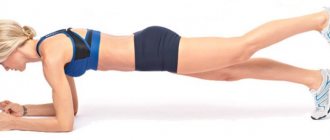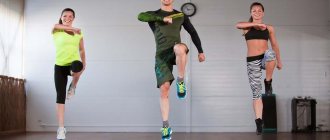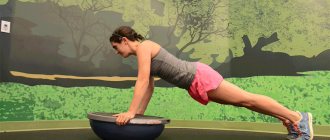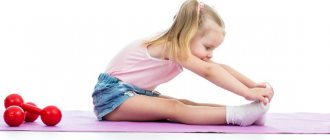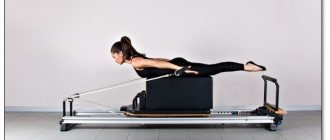Developing balance and stability helps improve performance in any sport, since the level of coordination of a person’s movements directly depends on this. Good coordination gives the athlete a sense of confidence in his actions and helps to protect himself from injuries associated with clumsiness in movements. If you can fall off your bike even on a straight road, or if you often fall while skating, then you urgently need to correct the situation by developing balance and stability. A set of exercises we have selected will help you do this.
Stretching the body into a horizontal plane while tilted
This exercise is also called the “swallow”, which is familiar to everyone from school years.
To do this you need:
a) stand on your left leg, with your right leg bent at the knee so that it forms a right angle, and also bend your arms at the elbows;
b) lean forward, slowly stretching your right leg back. Stretch your arms forward so that your body is in a horizontal plane and parallel to the floor;
c) return to the starting position;
You need to do this and other exercises to develop balance and stability in several repetitions, then change the static leg to the opposite one.
Brain development: useful tips and exercises
What makes a person human? There are many answers to this question, but one of the most common and true is that a person has high self-awareness, is able to think and has a brain that is many times more developed than the brain of any other living creature known to science. Over thousands of years of evolution, the human mind and brain have undergone a huge number of significant changes, and this progress itself is based on the ability to develop. It is for this reason that people have moved their thinking to a qualitatively new level.
But it’s easy to guess that humanity as a whole, and each of us individually, has not yet reached the peak of our capabilities. This means that the brain is still constantly developing. But what is more interesting is that we are able to influence the development of our main organ independently. Moreover, it is also everyone’s responsibility, because first of all, personal life results, work efficiency, success in learning, mastering new skills and communicating with others depend on the degree of brain development.
Taking into account all of the above, today we want to talk about brain development. Next, you will learn interesting information about the human brain, its functions and developmental features, useful tips, exercises and training methods. All of this can create an effective system for developing thinking that you can use every day. To begin with, we will say a few words about the human brain as a whole in order to better understand how to develop it as much as possible.
Briefly about the human brain
The human brain is the most mysterious and enigmatic organ, and many draw an analogy between it and a computer. Throughout his life, a person learns something and learns something new, and all information that is useful to him in one way or another goes into his memory and is stored there as long as he needs it. If some data becomes irrelevant, the brain simply erases it.
The functions of the brain can be listed for a very, very long time, but the main thing is that thinking, memory, imagination, speech, feelings, perception, and self-awareness depend on it. Naturally, this list is much larger, and if you want to learn more about the human brain and its development, you can find and read specialized books (Roger Sipe, John Medina, Dmitry Chernyshev and other authors).
The brain consists of the right and left hemispheres, connected to each other by the substance callosum, which serves to transmit information between them. If one hemisphere is damaged, the second is usually damaged as well. But there are cases when, for example, when the left hemisphere was destroyed, the right hemisphere took over its functions, and vice versa, thanks to which a person could continue to live a full life. As for these same functions, they are different.
The left hemisphere is responsible for logical thinking and working with numbers. It processes and analyzes information in a specific, strict sequence. And the right hemisphere is responsible for sensory perception and creative thinking - with its help music, smells, colors, art, etc. are perceived. This same hemisphere helps a person navigate the space around him. And thanks to its ability to synthesize existing information, a person gets the opportunity to think creatively, find non-standard solutions, solve puzzles, perform all kinds of exercises and play games to develop thinking and imagination (by the way, speaking about the development of thinking, it would not be superfluous to mention the course in cognitive science, after completing which you will be able to master twelve different thinking techniques).
In principle, the information considered is more or less sufficient for an approximate understanding of how the human brain works. And it only remains to note that thanks to special exercises the brain can be developed and made more powerful. However, it is very important to pay attention to the so-called preparatory activities, because it does not matter whether the brain of a child or the brain of an adult is trained, in any case it must be prepared for this.
How to prepare your brain for training
There are three basic rules that should be taken into account in order to make your brain more elastic, pliable and ready to perceive and assimilate new information, as well as its subsequent reproduction and competent application.
These rules include:
- Elimination of physical inactivity. This means that you must provide yourself with the necessary amount of physical activity. Physical inactivity is characteristic of people who lead a passive lifestyle or simply move little, for example, those whose activities involve spending a lot of time in a sitting position, for example, schoolchildren and students, who like to play computer games for hours or who love TV. And the negative consequences of physical inactivity are expressed in the fact that it does not allow fatty acids in the body to be broken down, which leads to the formation of cholesterol plaques on the vessels that interfere with normal blood circulation. Blood provides the organs, including the human brain, with the amount of oxygen they need, and if this process is disrupted, the functions of the brain are also disrupted, as a result of which the efficiency of its work deteriorates (in particular, physical inactivity negatively affects the brain of a child and an elderly person).
- Providing the body with phosphates and carbohydrates. Here we will only say that, firstly, you need to include in your diet foods rich in phosphorus (pumpkin, wheat germ, poppy seeds, soybeans, sesame seeds, processed cheese, nuts, oats, beans and others), as well as foods high in healthy carbohydrates (rice, corn flakes, bran, pasta, kefir, milk, shrimp, fish and others). By the way, here you can read about proper nutrition. And secondly, you should minimize or completely stop drinking alcohol, which has a detrimental effect on brain neurons. In addition to harmful alcohol, alcohol contains carbon dioxide, and together with alcohol it has a very powerful destructive effect on brain cells.
- Drinking water. We have already written in detail about the benefits of water, but now let us just remind you that clean water helps the body cleanse itself of toxins and waste, and also promotes the development of cognitive abilities, supporting neural connections. To provide yourself with the optimal amount of water, you should drink a liter of water per day per 30 kg of your body weight. If you are exposed to excessive stress, then it is advisable to increase the amount of water consumed even more.
By following these three rules, you will create a serious foundation for brain training. And any development system should be based on them - the brain of a child and the brain of an adult require special “care” and attention to themselves. And a lot of useful information on the presented topic is contained in thematic books (Roger Sipe, Mark Williams and Denny Penman, Alex Lickerman and other authors).
Development of both hemispheres of the brain
Let's remember: the left hemisphere processes speech and numerical information, logic, conclusions, analysis, linearity, etc. The right hemisphere provides spatial orientation, color perception, perception of shapes, sounds, colors, rhythms, dreams, etc. In general, of course, data is perceived by both hemispheres, but each of them predominates in its own area (you can read about functional asymmetry in this article).
Hence the conclusion: by developing one hemisphere, you can, for example, “train” in the ability to perceive images and become super creative, but at the same time experience serious difficulties in solving arithmetic problems. Or, conversely, you can become a pro in analytics, but be unable to see beauty in paintings or not be able to compose a banal four-line poem.
Therefore, educational institutions often teach not only core disciplines, but also those that are completely unrelated to the specialty. Remember the same mathematicians who study literature, history and other humanities subjects, or philologists whose schedule includes technical disciplines. This serves as further evidence that both hemispheres require development. And for this you can resort to the following exercises:
Exercise 1
For the first exercise you will need a partner. Let him blindfold you with something. Once this is done, take a short walk around the room or area where you are currently located. After that, answer the following questions:
- Has the activity of your senses increased, and if so, how?
- What helped you overcome the uncertainty of not being able to see?
- What sounds do you remember?
- Was there anything that worried you?
- Was there anything that calmed you down?
Based on these answers, you will understand how the body reacts to the shutdown of one of the senses. And the exercise itself will help you activate additional resources of both hemispheres.
Exercise 2
Through the second exercise, you will learn to synchronize the work of both hemispheres of your brain. It is done like this:
- Stand up straight and extend both arms forward or up;
- Draw a circle in the air with your left hand and a square with your right;
- Perform the exercise until you succeed, and then switch hands.
This exercise can also be complicated by drawing more complex shapes in the air with your hands. And based on the idea of the same exercise, there is even a special system for the development of both hemispheres. Its meaning is to do familiar things in non-standard ways. You can, for example, wash dishes, brush your teeth or eat with the other hand, hold the phone to the other ear, carry a bag or backpack on the other shoulder (the word “other” means the left side for right-handers, and the right for left-handers).
Exercise 3
A banal and simple exercise at first glance, but in reality it perfectly helps to synchronize the work of the right and left hemispheres. This is done as follows:
- Stroke your stomach with your right hand clockwise;
- Now with your left hand, lightly tap your head with vertical movements;
- After a little practice, perform the indicated movements at the same time.
It is interesting that very often the hands themselves begin to confuse the movements: the left hand does what the right hand should, and the right hand does what the left should. The exercise is very interesting, and after the first option is mastered, simply change hands.
It is very effective to use these three exercises when you want to influence the child's brain. But they will also be extremely useful for adults - despite their apparent simplicity, they perfectly train the brain, as a result of which thinking, memory, imagination, etc. improve. But it will be even better if you combine your training with the development of thinking, for example, by taking a course in cognitive science.
The exercises of the two subsequent groups can be performed separately and together with each other, as well as in combination with those already discussed. It depends on your personal needs and preferences.
Development of the left hemisphere of the brain
Here we will also look at three exercises:
Exercise 1
The meaning is very simple - you just need to perform all actions and manipulations with objects in the surrounding world using your right hand. Although this is natural for right-handers, even for them it will be extremely unusual, and left-handers will get excellent practice.
Exercise 2
This exercise is not much more complicated than the previous one - to develop the left hemisphere, spend a little time every day on logic games and solving arithmetic problems.
Exercise 3
Again, a very simple exercise - solve crosswords and scanword puzzles for 30-40 minutes every day. Solving them is considered to be largely an analytical rather than an intuitive process, which means that the left hemisphere is involved in it.
Development of the right hemisphere of the brain
There are four exercises in this group:
Exercise 1
Systematically listen to your favorite music that promotes relaxation and fantasy, because... This is what the right hemisphere of the brain is responsible for. The more relaxed you feel, the better.
Exercise 2
To develop the right hemisphere, perform all actions and manipulations with objects in the surrounding world with your left hand. If in the previous block left-handers experienced inconvenience, then in this case right-handers will have to try. By the way, it will be cool if you learn to read and write from right to left, for which it is very effective to practice Arabic writing. At the same time, you will learn a foreign language and train your memory.
Exercise 3
Because the right hemisphere is more likely to synthesize rather than analyze data; spend time drawing, because it is during drawing that abstract thinking develops. Set aside 30 minutes daily for this. In addition, drawing can be replaced or combined with interior or clothing design. An additional advantage of this exercise is the development of intuition.
Exercise 4
Develop empathy. This means that you need to develop the ability to empathize and perceive the world through the eyes of other people. Taking this into account, the right hemisphere is developing just fine, and you can learn more about the development of empathy by clicking on this link.
All the exercises we talked about, when performed regularly, will make your mind sharper and more flexible, and your brain trained and capable of serious achievements. The most important thing is to remember to pay attention to both hemispheres.
And finally, some more good tips for brain development:
- Do sports (do exercises, go to the pool, jog, etc.);
- Communicate with people around you on interesting topics;
- Provide yourself with good sleep and good conditions for rest;
- Eat right and eat more vitamin-rich foods;
- Develop stress resistance and positive thinking;
- Play educational games and chess;
- Read educational literature and educational books (Roger Sipe, Carol Dweck, Arthur Dumchev, etc.);
- Educate yourself and take courses on developing thinking (a course in cognitive science here).
This development system will allow you to always grow personally, train your intellect and have an active, healthy and strong brain. We wish you success and the opportunity to use your potential to the maximum!
We also recommend reading:
- Creativity and logic: the myth of functional asymmetry of the cerebral hemispheres
- Brain structure
- Logic vs intuition
- Books about development and for development
- What are cognitive abilities
- 10 myths about the functioning of the brain: truth and fiction
- Intelligence and its development: several recommendations
- Right-brain thinking: meaning and exercises for development
- The role of art in children's development
- How to Switch to Creativity: Right Brain Training by Betty Edwards
Key words:1Cognitive science
Jump forward/backward on one leg
a) first stand on your right leg, while bending your left leg at an angle of 90 degrees;
b) then - jump forward several times in a row, not allowing your bent leg to touch the floor;
c) return to the starting position in order to change legs and continue the exercise.
The same algorithm of actions is used when jumping backwards on one leg.
Physical exercise
Research from 2006 shows that exercise has huge benefits for our brains. In particular, exercise can protect our brains from shrinking as we age.
While exercise may not be the most fun or challenging exercise for your brain, it is one way to get double the benefits.
In addition to the benefits for the body, incorporating new physical exercises triggers new signals in our brain. This increases the plasticity of our brain - the ability to change and think differently. Thus, doing new exercises will strengthen our brain.
Bend forward while standing on one leg
a) you need to stand on your right leg, the left leg should be bent at an angle of 90 degrees. It is better to place your right hand on your belt and press your left hand to your chest.
b) lean forward and, maintaining balance, touch the toe of your right foot with your left hand.
c) slowly rise to the starting position, and after performing several repetitions, change legs.
In order to increase the load on the muscles, you can use a small dumbbell and bend over, holding it in one hand.
Learning something new
Starting something new requires a lot of mental capacity. Not only are you learning to do something new, but you also have to stay motivated to keep doing it. Because of this, learning something new will keep us on our toes.
What's also good is that the activities don't have to be really complicated. For example, in one study there were two groups and they were asked to perform different activities. One group was asked to learn a new skill, such as quilting or digital photography. Another was asked to watch movies or listen to the radio.
The study found that those who quilted or took digital photography had better memory than those who engaged in more leisure activities.
Reading books
People who read books are more likely to have healthy brains later in life, according to a study published in the journal Neurology. The study looked at 294 older participants and found that those who took part in mentally stimulating activities such as reading had lower rates of mental decline as they got older. Conversely, those who rarely read or performed other mentally stimulating activities declined mentally 48 percent faster than average.
- 7 Scientific Reasons Why You Should Read Books
Neurobics
This training method for our brains was invented by Americans - neuroscientist Lawrence Katz and writer Manning Rubin . And for 15 years now, the world has been studying the book “Fitness for the Mind,” choosing the most suitable of 83 exercises to improve memory and develop intellectual abilities.
To perform fun exercises, you will have to get a little “wonderful”, do daily tasks in a slightly extravagant way, using all 5 senses in an unusual combination. Doing the same routine work makes it difficult for us to focus on new things: memory weakens and concentration falls. But if you do familiar things in an unexpected way, the brain has to build fresh connections between nerve cells and restore them if they have been lost.
Try to develop a craving for everything unusual in every free minute, doing household chores, on the way to work and to the store, sitting in front of the TV or at the computer. Do the exercises cheerfully, ironically, in a good mood - the brain really likes emotions.
The brain from the point of view of cybernetics[ | ]
From the point of view of cybernetics, the brain is a giant learning statistical analog machine made of living ionic elements without a rigid structure of connections between elements, with a power consumption of about 25 {\displaystyle 25} Watts. Estimates of brain memory capacity by various authors range from 10 6 {\displaystyle 10^{6}} to 10 16 {\displaystyle 10^{16}} bits[29][30]. Higher nervous activity consists of working with images of the external world using a multi-stage hierarchical method of parallel information processing [31] [32]. Brain memory is structured according to a special principle - the information being remembered is at the same time the storage address in the cerebral cortex, and not only the information is remembered, but also the frequency of its repetition.[30] The connections of brain neurons form a multi-level network structure[33].
The first attempts are being made to create mathematical models of the brain based on the theory of automata, neural networks, mathematical logic, cybernetics[34][35][36]
American scientists tried to compare the human brain with a computer hard drive and calculated that human memory can contain about 1 million gigabytes (or 1 petabyte) (for example, the Google search engine processes about 24 petabytes of data daily). Considering that the human brain spends only 25 watts of energy to process such a large amount of information, it can be called the most efficient computing device on Earth[37].
